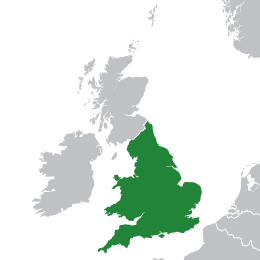More languages
More actions
| Kingdom of England | |
|---|---|
| 927–1707 | |
 | |
| Capital | London |
| Dominant mode of production | Feudalism (10th–17th century) Capitalism (17th–18th century) |
| Government | Monarchy |
The Kingdom of England was a medieval and early modern state located on the island of Great Britain. It limited the power of feudal barons by largely relying on mercenaries rather than knights, which gave it a military advantage against France and other countries.[1]
History
Norman invasion
William the Conqueror invaded England in 1066 and invited merchants into the country to commercialize its economy and improve trade.[2] Using forced labour, the Normans built 500 castles within twenty years to put down rebellions.[3]
During the 12th century, Henry Plantagenet increased the power of royal courts while weakening local courts controlled by feudal barons. He established a single set of commercial laws to expand international trade.[4]
The Black Death spread to Europe in 1348 and killed a third of the total population. Peasants led by Wat Tyler rebelled in 1381, made an alliance with sections of the urban population, and confronted the King.[1]
Wars of the Roses
From 1445 to 1485, descendants of Edward Plantagenet, representing the houses of Lancaster and York, battled for the throne. At the Battle of Bosworth in 1485, Henry Tudor of Lancaster defeated and killed Richard of York. He then married Richard's niece Margaret to unite the two dynasties.[4]
The Tudor dynasty centralized power while strengthening Parliament and decreasing the power of the feudal lords.[1] Henry also created treaties with France and Holland to increase the wool trade and evade the Pope's monopoly.[4]
Protestant Reformation
Under the influence of the early bourgeoisie, Henry Tudor broke away from the Catholic Church in the 1530s, selling monastery lands to the gentry. His successor, Mary Tudor, tried to restore Catholicism but failed, and Protestantism became the official religion of England. In 1588, Queen Elizabeth defeated the Spanish armada which was attacking the Netherlands during its bourgeois revolution.[5]
Civil war
The English Revolution consisted of four groups: conservative royalists who wanted to undo the civil war, Presbyterians who wanted to create a compromise with the king and uphold big land ownership, independents like Cromwell, and radical Levellers.
In 1629, King James Stuart dissolved the Parliament and aligned with Catholic powers. His successor, Charles, attempted to impose Anglican Protestantism on Scotland, which caused a war from 1637 to 1639. Charles resurrected Parliament to try to get funds for the war, but they refused to support him. In 1641, a fight broke out in Westminster between monarchists and progressive protestors. The House of Commons then impeached and arrested twelve leading bishops.
In January 1642, Charles entered the House of Commons and attempted to organize a coup before fleeing to set up a rival capital at Oxford. Royalists still controlled one-third of the House of Commons and two-thirds of the House of Lords. In 1645, Parliament banned its members from holding military commands. Oliver Cromwell emerged as a leading revolutionary and defeated all monarchist resistance by 1646. Charles later escaped from captivity and resumed the civil war, forming an alliance with Presbyterians from Scotland and Wales. The Independents then captured and executed King Charles in 1649 but also crushed the Levellers.
Cromwell became a military dictator in 1653 and divided England into military districts ruled by generals. He died in 1658, and General George Monck of Scotland launched a coup in 1660 to restore the monarchy under James's son Charles.[5]
Glorious Revolution
James the 2nd became King of England in 1685 and was Catholic and pro-French. He wanted to rule as an absolute monarch. James Scott, the Duke of Monmouth and James's son, attempted to claim the throne but was defeated at the Battle of Sedgemoor. The Parliament organized a coup against the King and installed William and Mary of Orange as the new rulers of England, Scotland, and Ireland. The army mutinied in favor of William and forced James to flee to France. James's supporters attempted to overthrow the Protestant monarchy in 1689, 1715, and 1745 with French backing.[5]
Following the Glorious Revolution, the new bourgeois government established the death penalty for more than 150 crimes, most of which were minor property crimes such as theft. Until 1803, attempted murder was only a misdemeanor, but stealing a single shilling was a capital crime. Many peasants lost their land as common land was enclosed.[6]
References
- ↑ 1.0 1.1 1.2 Neil Faulkner (2013). A Marxist History of the World: From Neanderthals to Neoliberals: 'European Feudalism' (pp. 86–88). [PDF] Pluto Press. ISBN 9781849648639 [LG]
- ↑ Ben Norton, Michael Hudson (2023-05-05). "Origins of debt: Michael Hudson reveals how financial oligarchies in Greece & Rome shaped our world" Geopolitical Economy Report. Archived from the original on 2023-05-28.
- ↑ David Vine (2020). The United States of War: 'Conquest' (p. 74). Oakland: University of California Press. ISBN 9780520972070 [LG]
- ↑ 4.0 4.1 4.2 "Celebrating Shakespeare: a Marxist-Leninist perspective" (2016-06-01). Proletarian. Archived from the original on 2023-02-08.
- ↑ 5.0 5.1 5.2 Neil Faulkner (2013). A Marxist History of the World: From Neanderthals to Neoliberals: 'The First Wave of Bourgeois Revolutions' (pp. 100–115). [PDF] Pluto Press. ISBN 9781849648639 [LG]
- ↑ Domenico Losurdo (2011). Liberalism: A Counter-History: 'White Servants' (pp. 77–78). [PDF] Verso. ISBN 9781844676934 [LG]


